Minecraft - a sandbox with boundless imagination
Everyone has at least once seen angular characters in a motley world assembled from cubes, met "Minecraft" videos on YouTube with millions of subscribers, read in the news about schoolchildren who built something grandiose in the virtual universe. Today, Markus Persson's work has become a cultural phenomenon rather than just fun. Minecraft is used for education, business, and complex projects up to life-size recreations of entire cities. There's a lot more to Minecraft, but let's talk about it in order.
What is Minecraft?
The essence of the game is reflected in its name. It relies on two key mechanics: mining materials by destroying cubes-blocks, of which the environment consists, and assembling all kinds of objects from them. That is, in the language of gamers, mining and crafting. This is a standard example of the sandbox genre - a huge world you can explore in any direction and create anything you want in it. And everything in Minecraft gets destroyed, from trees and soil to diamonds in the depths of mountains.
The choice of materials allows you to create objects for any purpose and any property, including complex mechanisms: mini-games like tetris or kilometer-long pixel-art-style panels. Using blocks that have two states and can switch between them by signal, you can build a computer and do calculations on it. Given the lack of any hints, this all seems complicated to a beginner. Does such an unsightly pastime require technical knowledge and skill? No! In fact, everything is much simpler.
The choice of materials allows you to create objects for any purpose and any property, including complex mechanisms: mini-games like tetris or kilometer-long pixel-art-style panels. Using blocks that have two states and can switch between them by signal, you can build a computer and do calculations on it. Given the lack of any hints, this all seems complicated to a beginner. Does such an unsightly pastime require technical knowledge and skill? No! In fact, everything is much simpler.
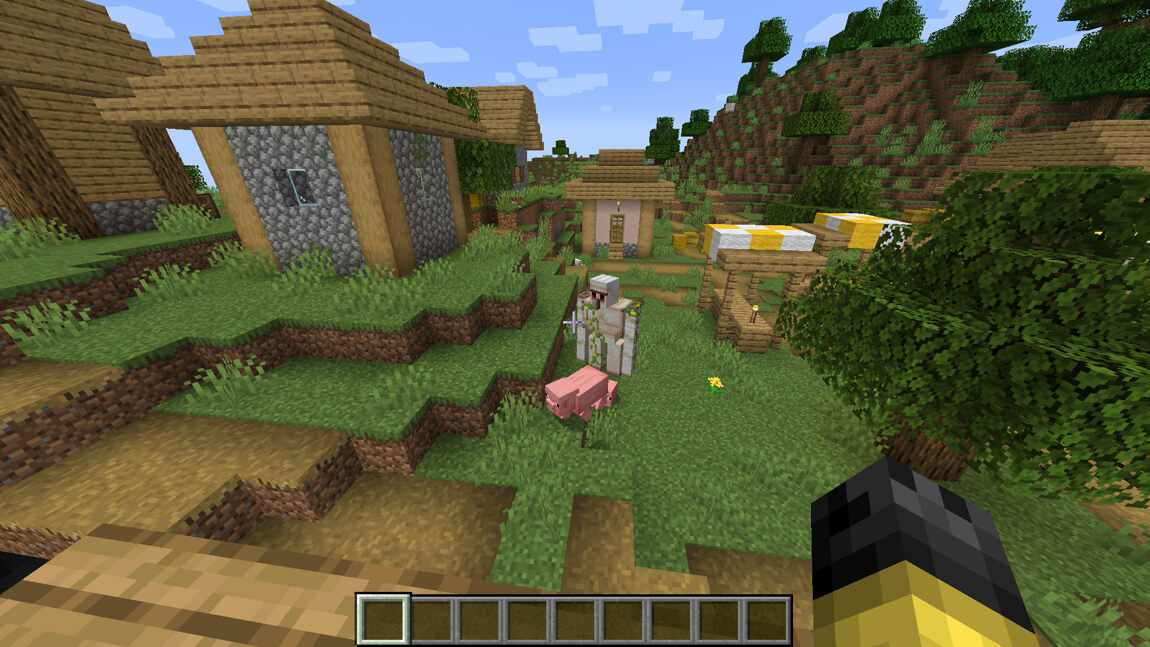
In 2009, when the idea of Minecraft first appeared in the mind of the Swedish programmer Markus "Notch" Persson, the game seemed rather primitive. He took Infiniminer as a base, where you had to destroy stone cubes for a while with the help of improvised means. Since the Infiniminer writers withdrew their support from their brainchild and released the code to the public, the mechanics behind that game became a common property and served as a model for a mass of variations. Marcus decided it would be a good idea to combine destruction with construction and add new types of blocks at the same time. Instead of gray stone, Persson drew earth, grass, trees, sky, clouds, and his "sandbox" became more colorful.
Initially, the development was based on adding blocks with new characteristics. For example, there appeared flowing water with lava and loose sand. Also the "Minecraft" universe was filled with creatures: pets; giant spiders; skeletons; zombies and creepers - armless green monsters that can explode and, unlike other enemies, do not burn at dawn. Prefabricated objects available for quick assembly from looted materials were also invented: beds; doors; fences; torches; wooden signs; equipment items. The change of day and night, the dynamics of weather conditions appeared - now the sun shines, now it pours rain.
But no matter how "meat" no matter how the skeleton of the game, its basis remained the same - in order to create something, you need to destroy something and get the necessary components for construction. Further creativity depends on the imagination of the user. Like to build towers to the clouds or dig tunnels comparable to the Mines of Moria in The Lord of the Rings? So be it! Craving engineering feats? Cheers! Imagine a construction set of blocks, which is not limited to any theme and a picture with the final product on the box. That would be Minecraft.
Initially, the development was based on adding blocks with new characteristics. For example, there appeared flowing water with lava and loose sand. Also the "Minecraft" universe was filled with creatures: pets; giant spiders; skeletons; zombies and creepers - armless green monsters that can explode and, unlike other enemies, do not burn at dawn. Prefabricated objects available for quick assembly from looted materials were also invented: beds; doors; fences; torches; wooden signs; equipment items. The change of day and night, the dynamics of weather conditions appeared - now the sun shines, now it pours rain.
But no matter how "meat" no matter how the skeleton of the game, its basis remained the same - in order to create something, you need to destroy something and get the necessary components for construction. Further creativity depends on the imagination of the user. Like to build towers to the clouds or dig tunnels comparable to the Mines of Moria in The Lord of the Rings? So be it! Craving engineering feats? Cheers! Imagine a construction set of blocks, which is not limited to any theme and a picture with the final product on the box. That would be Minecraft.
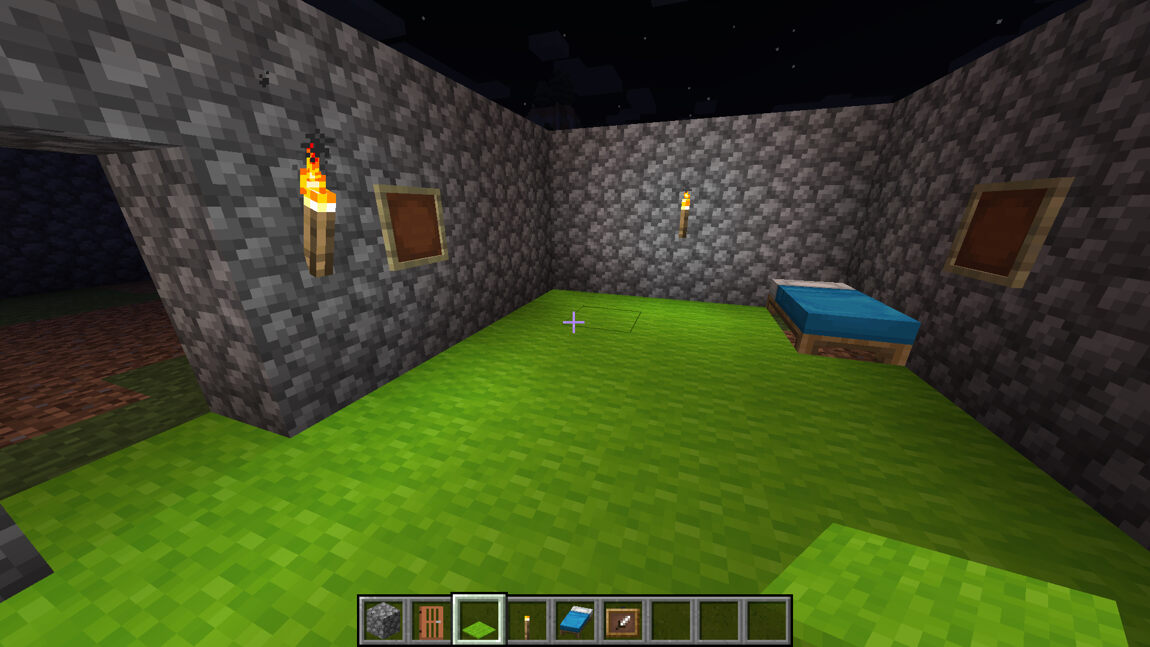
The second important idea of the project is continuous improvement. Even at the alpha and beta stages, Persson realized that his work would not be complete even after its official release. If not the author himself, then the fans will make the content, create modifications and somehow influence the development of "Minecraft". It is no coincidence that a big role in the promotion of "sandbox" played the public. As the development of people offered modes, items, mechanics, and at the same time came up with different legends, a great influence on the excitement around the game. One of these legends was Hirobrin - the eyeless character, who was believed to be either the dead brother of "Notch", or the ghost of a miner. Both versions were not confirmed, but there were more and more such stories, and eventually they formed a special mythology of the game world.
In 2014, Markus Persson sold Minecraft to Microsoft for $2.5 billion. Despite the change of ownership of the game, the author's principles remained unchanged. The tandem of destruction and construction is still at the head of the game, as well as the continuous development of the project. Until now go out patches and modifications. We can say, to the final release of "Minecraft" has not yet reached, but it does not prevent him to be one of the greatest interactive works in history.
In 2014, Markus Persson sold Minecraft to Microsoft for $2.5 billion. Despite the change of ownership of the game, the author's principles remained unchanged. The tandem of destruction and construction is still at the head of the game, as well as the continuous development of the project. Until now go out patches and modifications. We can say, to the final release of "Minecraft" has not yet reached, but it does not prevent him to be one of the greatest interactive works in history.
How does the adventure begin?
At the start, the game prompts you to choose a mode and create a new world, which is randomly generated. You can tinker with the settings and set some initial parameters, such as humidity and the number of plants in the character's birthplace, but the rest of the terrain and geological structures will still be random. The generation process is very original, it does not go all the way to the end - the program builds blocks as you move through the virtual universe. To estimate the scale of the map, suffice it to say that it can hold quadrillion blocks and exceed the real size of the Earth by times. The desire to travel around the world in the game is going to be a challenge for both the gamer and his equipment. However, if you press W on the keyboard for months on end, without turning off the computer and the game, your hero will still come to, the so-called "Far Lands", where the algorithm of world creation begins to fail.

As for modes, there are three main modes in Minecraft: "Creativity", "Survival" and "Hardcore". Through the console, by pressing the tilde (~) on your keyboard and typing the appropriate command, you can select additional modes, such as "Survival", which allows you to fly through the blocks, but not to destroy and build anything. Since these are optional formats, let's talk more about the main ones:
- "Creativity" is arranged so that the player is not distracted by unnecessary actions, giving free rein to his imagination. There is no health and hunger scale, any blocks are destroyed with a single hit, and the inventory already contains cubes of all stripes - there is no need to mine even rare materials. In addition, there is a function of flight, for which it is enough to press the "Spacebar" twice and set the direction. Moreover, falling from a height does not cause any damage to the character. In short, a mode for those who would like to build something without fighting with zombies, working with a pickaxe in the mine and fighting for life.
- "Survival" requires much more effort: you have to get food and building materials, monitor the health of your character, defend yourself from monsters, and generally be careful, because a fall from a high wall may result in injury or death of your character. Of course he will revive, but he will lose everything he gathered in his inventory before his infamous demise. In order to get back at least a part of the lost goods you will have to find the place of death. Destroying and building here takes a lot more time and effort than in Creation. In addition, you have to keep up with technology: first you wield a wooden pickaxe, then you build a stone pickaxe and then an iron pickaxe to extract increasingly stronger materials. The same goes for armor: the more formidable the monsters, the stronger the defense must be. Survival" is a better introduction to Minecraft than the other modes, because it offers not only building, but also learning nuances that are not available in "Creation".
- "Hardcore" is essentially the same as "Survival", only the difficulty level here is the default maximum, and the character has only one life. That is, after the death he will not be able to revive and get into the world, where you have already managed to get or build something. This mode is probably not suitable for a beginner.

To understand where you've been taken, all you have to do is look around. Do you see hills covered with oaks and birches, lakes and small glades where cows and pigs graze? You are lucky - the animals will give you the food you need to survive, the land will serve as the first building material, and the plants will provide wood for building tools. Deserts or islands in the sea, on the contrary, can be classified as an unfortunate starting point - there are not many minerals, the area looks boring, and with the construction at first not too much turn around. When appearing in an unattractive biome, it is better to generate the world anew than to create unnecessary difficulties. However, even in the most squalid terrain there is a chance to appear near a village or fortress - a structure containing a bunch of useful items, not to mention a ready-made shelter.
On the other hand, the starting point in a good biome can be located near an outpost of bandits, the hostile inhabitants of the Minecraft world. In Survival and Hardcore, this is an extremely unfortunate proximity. While monsters will pester you at night, outlaws will interfere with hunting, gathering, and tree-cutting during the day. In addition, they are not badly armed, and your character, at first, has no armor, no crossbow, no normal sword.
Along with biomes in the game universe there are dimensions: the Upper World, the Lower World and the Edge. The first is the very map where you appear. The usual laws of nature apply here: there is a change of time of day and weather, and landscapes and vegetation are painted in familiar colors. Creatures, or as they are more commonly called "mobs," are divided into three categories in the Upper World:
On the other hand, the starting point in a good biome can be located near an outpost of bandits, the hostile inhabitants of the Minecraft world. In Survival and Hardcore, this is an extremely unfortunate proximity. While monsters will pester you at night, outlaws will interfere with hunting, gathering, and tree-cutting during the day. In addition, they are not badly armed, and your character, at first, has no armor, no crossbow, no normal sword.
Along with biomes in the game universe there are dimensions: the Upper World, the Lower World and the Edge. The first is the very map where you appear. The usual laws of nature apply here: there is a change of time of day and weather, and landscapes and vegetation are painted in familiar colors. Creatures, or as they are more commonly called "mobs," are divided into three categories in the Upper World:
- Friendly. Such as: villagers; merchants; pigs; llamas; horses; sheep; donkeys and cows; will not touch your character, and you can even be friends with some of them (in the case of animals, tame them)
- Neutrals. Mobs like dolphins, spiders and bears - serve as a source of resources.
- Hostile. Accordingly, attack you at the first opportunity. Most enemies are monsters that only operate at night. Under the first rays of the sun, all sorts of zombies with skeletal archers burn out.
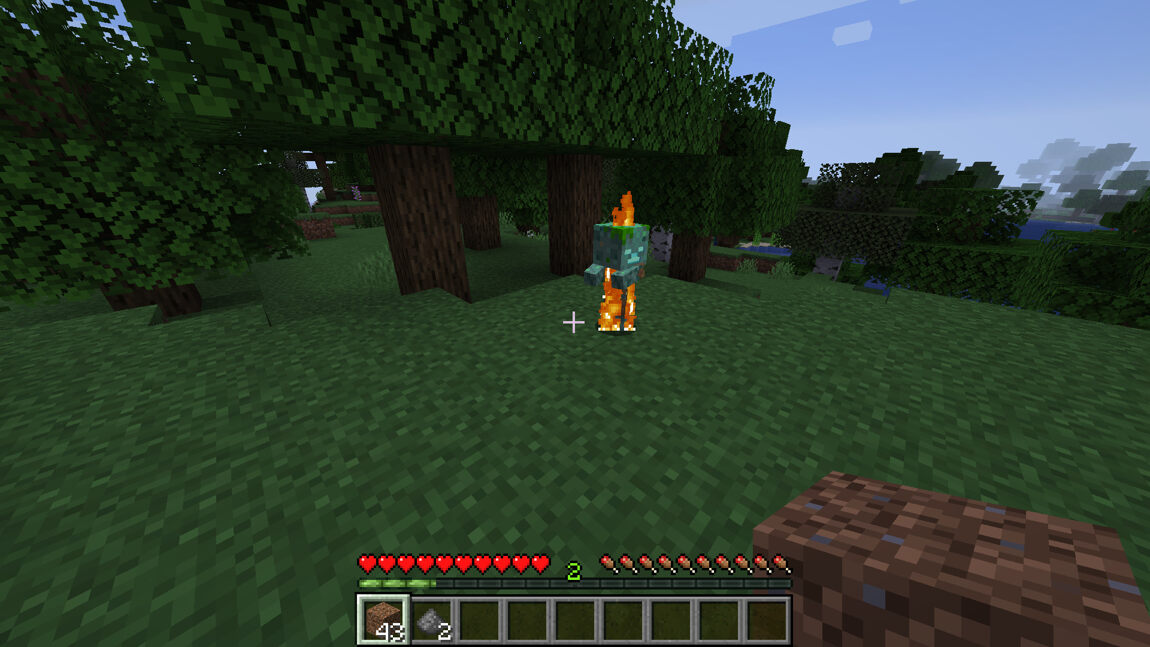
The underworld, aka Hell. It is the same huge space as the usual map, only everything in it is painted in gloomy colors. There is neither day nor night - everywhere there is only lava and red-hot rocks, and special creatures live in this macabre area: hoglins, pyglins and ifrites. Here you can find unique biomes, such as the Warped Forest or Basalt Deltas, and materials that are not found in other dimensions. To enter the in-game Hell, you must build a portal of obsidian ranging in size from 4x5 to 23x23 blocks and then light it with a flamethrower and place your character under the arch for at least four seconds. Visiting the Lower World in "Survival" and "Hardcore" modes is a dangerous venture, because the cubes and enemies here exhibit unexpected properties, so you should make such a journey after thorough preparation.
The Edge. A dimension where islands fly above the ground and where the mighty dragon dwells. If you've found the portal in the Upper World and used it, the way back will be closed until you fight this dragon. Obviously, you'll only have to fight if you're A+ equipped. At this point you might ask: why visit such unfriendly places and challenge dangerous monsters in a game that works like a construction set? Yes, Minecraft, with the exception of some modifications, does not set any goals for gamers and does not offer a coherent story, but no one prevents you from assigning yourself a goal and come up with your own adventure just as a house is assembled of cubes.
The Edge. A dimension where islands fly above the ground and where the mighty dragon dwells. If you've found the portal in the Upper World and used it, the way back will be closed until you fight this dragon. Obviously, you'll only have to fight if you're A+ equipped. At this point you might ask: why visit such unfriendly places and challenge dangerous monsters in a game that works like a construction set? Yes, Minecraft, with the exception of some modifications, does not set any goals for gamers and does not offer a coherent story, but no one prevents you from assigning yourself a goal and come up with your own adventure just as a house is assembled of cubes.
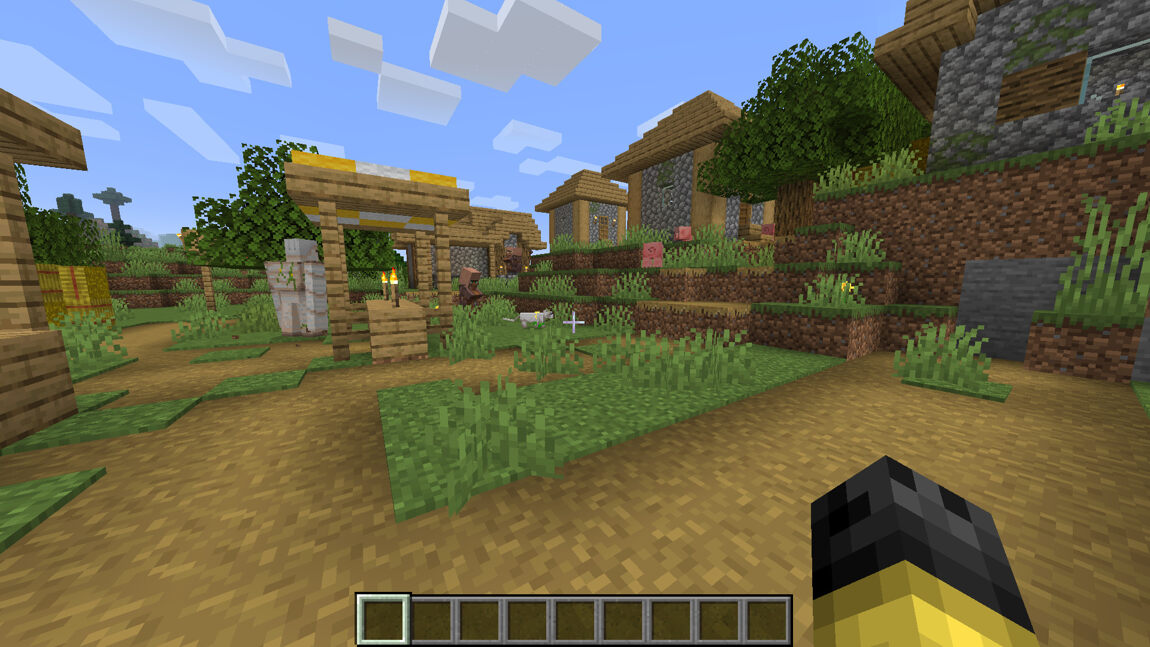
The most logical thing to strive for in Survival and Hardcore is to collect achievements, including an achievement for visiting all available biomes. Many players see the ultimate goal of their wanderings as killing the dragon Krai or the Ifrit in the Lower World. Some pursue the wanderer Enderman of the Edge (a skinny black giant Neutral) in order to kill him and obtain a rare resource (the pearls of the Edge), which serves as a sort of item-enhancing artifact from traditional role-playing games. You can explore the depths of the sea and fight an ancient guardian in an underwater temple. In other words, everyone is free to set a Minecraft goal and move towards it, overcoming difficulties. On the construction of the blocks is not a swept away. Although, without the knowledge of this base still can not do.
Mining and Krafting
So you're in the middle of a virtual world, with no tools or food supplies. But at the bottom of the screen, if you selected "Survival" or "Hardcore," two scales - hunger and health - ring a bell. What to do? As has already been said, there are no tips in "Minecraft", so you will have to learn the basics on your own. Fortunately, the study of the basics of the game is not difficult. The first thing you should prepare for the night. With his bare hands (by clicking the left mouse button) the character is able to dig earth and get a lot of useful materials. Are there trees growing nearby? They will come in handy! Break them down into cubes, which are automatically added to your inventory as soon as you get close to them
In the same way you can kill grazing pigs, chickens, sheep and cows without any implements, and at the same time prepare a shack by assembling it from any blocks. Creation of new cubes (that is, construction) is done by right-clicking. At first, even a dugout will do as a shelter, as long as it protects from uninvited guests in the dark. By the way, don't forget about the roof, otherwise the flying creatures will give you a lot of trouble.
In the same way you can kill grazing pigs, chickens, sheep and cows without any implements, and at the same time prepare a shack by assembling it from any blocks. Creation of new cubes (that is, construction) is done by right-clicking. At first, even a dugout will do as a shelter, as long as it protects from uninvited guests in the dark. By the way, don't forget about the roof, otherwise the flying creatures will give you a lot of trouble.
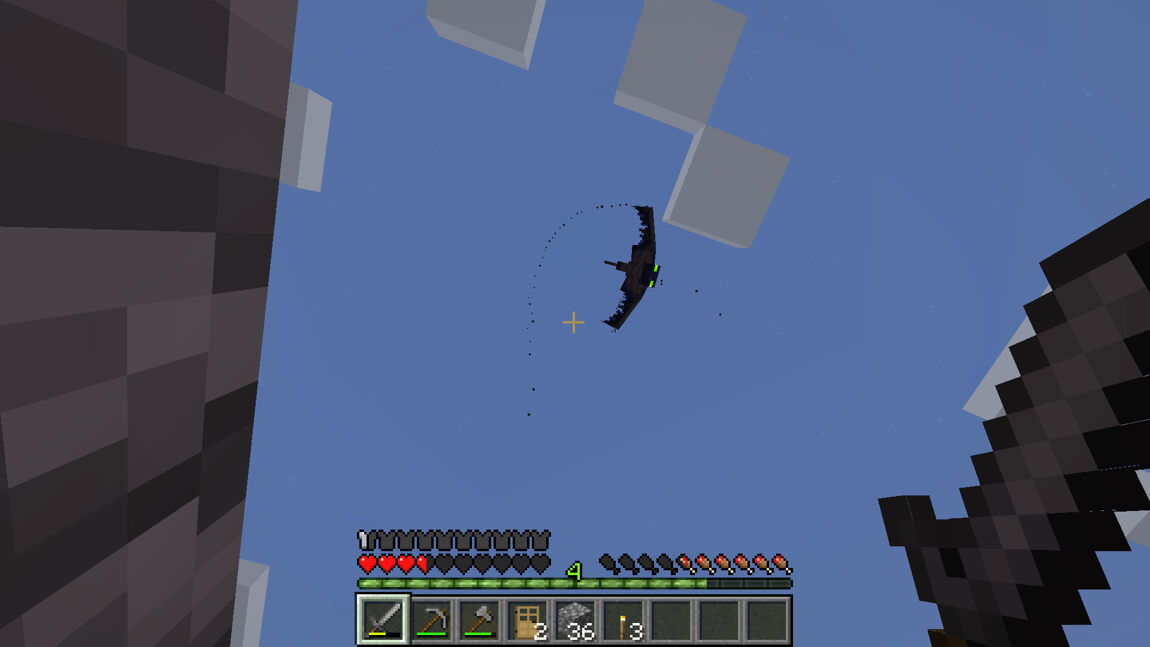
With the extracted wood begins to create items according to recipes. If you play on the computer, then to open the window of crafting, just press "E" and click on the image of the book, after which a field of 2x2 cells will appear, where you need to add resources, and in the cell on the right - to take the finished thing. For example, from the same wood you can whittle planks and sticks, and four planks when combined give a workbench. This indispensable tool contains 3x3 squares and produces more complicated things, such as: pickaxes; shovels; axes; swords; armor and interior items for your character's residence. The workbench is where you make your first wooden tools.
Of course, you can chisel the ground or stone with your bare hands, but with pickaxe and shovel, even birch ones, the work goes a little faster. Speed is important, because the daylight hours in Minecraft last 10 minutes of real time, and to get the coal from the Earth's depths is better before dark, because without this material can not make a torch. With light, you'll find something to do even at night, because no one's stopping you from digging a mine right inside the hut: first you get the earth, then cobble, granite, basalt, andesite, gravel, blocks with black flecks of coal, and yellowish iron rock. There are dozens of minerals with unique properties in the game. Underground caves hold many surprises: there may be a monster in them, or lava will burn, but sometimes there is something valuable. However, if you try to collect all the cubes in a row, there is not enough space in the inventory. So you have to make chests to store supplies.
Gradually you unlock more and more items, including blocks with interfaces. The first representative of this class of objects is the workbench. Then an oven becomes available, where you can roast meat with wood, bake bread, and then even melt metals. There is also an anvil, a weaving loom, and a cooking rack that allows you to prepare potions. An important unit with the interface is the bed, thanks to which you can skip night time and only do creative work during the day. To make it you need planks and sheep's wool.
Of course, you can chisel the ground or stone with your bare hands, but with pickaxe and shovel, even birch ones, the work goes a little faster. Speed is important, because the daylight hours in Minecraft last 10 minutes of real time, and to get the coal from the Earth's depths is better before dark, because without this material can not make a torch. With light, you'll find something to do even at night, because no one's stopping you from digging a mine right inside the hut: first you get the earth, then cobble, granite, basalt, andesite, gravel, blocks with black flecks of coal, and yellowish iron rock. There are dozens of minerals with unique properties in the game. Underground caves hold many surprises: there may be a monster in them, or lava will burn, but sometimes there is something valuable. However, if you try to collect all the cubes in a row, there is not enough space in the inventory. So you have to make chests to store supplies.
Gradually you unlock more and more items, including blocks with interfaces. The first representative of this class of objects is the workbench. Then an oven becomes available, where you can roast meat with wood, bake bread, and then even melt metals. There is also an anvil, a weaving loom, and a cooking rack that allows you to prepare potions. An important unit with the interface is the bed, thanks to which you can skip night time and only do creative work during the day. To make it you need planks and sheep's wool.

Recipes for all items and devices are unlocked one by one as you interact with new materials. The same circumstance requires you to constantly improve your equipment. For example, you can get an ordinary cobblestone with a wooden pickaxe, and you need at least a stone pickaxe for coal. Gold can not be broken without an iron tool, and obsidian lends itself only to a diamond tool. The same progress is associated with other items of equipment: iron armor holds the blows of skeletons and zombies, but going against a dragon in it is a crazy idea.
A standout in the remaking of the virtual world in its own way is farming. It's also a creative process that requires patience. If you have found the seeds of wheat or carrots, do not throw them away. Once you've established a farm, you can feed the plants to the animals so that they multiply and steadily supply you with some resources. Sheep give wool, chickens give eggs, donkeys give skins, and pigs give meat. Tree saplings, found while clearing forests, provide wood when there's not a branch around, and a cocoa plantation lets you make delicious cookies. Meet in Minecraft and very unusual farms. For example, if you breed cats, they will scare away creepers from their homes, and a hellbender farm brings material that's usually only available in the Underworld.
A standout in the remaking of the virtual world in its own way is farming. It's also a creative process that requires patience. If you have found the seeds of wheat or carrots, do not throw them away. Once you've established a farm, you can feed the plants to the animals so that they multiply and steadily supply you with some resources. Sheep give wool, chickens give eggs, donkeys give skins, and pigs give meat. Tree saplings, found while clearing forests, provide wood when there's not a branch around, and a cocoa plantation lets you make delicious cookies. Meet in Minecraft and very unusual farms. For example, if you breed cats, they will scare away creepers from their homes, and a hellbender farm brings material that's usually only available in the Underworld.
Creating complex designs
With static objects, like houses or fences, the case is clear - built and stand quietly, do not ask to eat, but the game also allows you to create mechanisms, actuated by a signal. For example, you can make doors that open only by pressing a button, or a trap to send uninvited guests straight into a pit with lava. Not to mention the solutions useful in mining: self-propelled wagons, explosives with a timer and remote control, automatic mine lighting and other gizmos that seem complicated only at first glance.

The first mechanism available in Minecraft is a lever - to make one, you simply connect a stick and a block boulder on the workbench. Like any switch, it can open and close doors, interrupt electrical signals, and act as a railroad track switch. As for energy, its source and conductor is redstone, aka redstone. This useful mineral is extracted from redstone ore with iron, diamond or enchanted pickaxe. However, you still need to get to the right layers. Typically deposits are generated in the lower 16 levels of the game world. But, having got the redstone, you'll be able to use a lot of mechanisms, collected by recipes. There are different types of such devices:
- Switches: levers, buttons, pressure plates, trap chests, daylight sensors-in short, anything that works on/off.
- Pistons that push the blocks in front of them on signal. With these components, you can, for example, build sliding and lifting doors, like in Star Wars.
- Rails - are used to move the carriages. Unlike normal rails, electric ones allow for speeds of up to 8 meters per second and allow you to stop the carriage at any point on the route when signaled.
- Sash mechanisms: doors, hatches, gates.
- The compass is a useful thing in the Minecraft world, where it's easy to get lost. As you explore the map, you can move further and further away from the hero's point of origin, but if he is killed, he will be reborn in approximately the same place where he first appeared. This is where the arrow points to, letting you know where you were coming from and where you were going.
- The observer is the mechanism that monitors the state of the block opposite the plane with the sensor. At any change in the adjacent cube, the observer gives a signal of 1 beat of red stone, i.e. 0.1 second. In other words, by connecting it to a light or sound source, an alarm can be made.
- The repeater and comparator play an important role in complex designs. The first allows you to delay and amplify the signal coming to it, and the second compares two incoming signals and subtracts one from the other.
- Light and sound blocks - as it is easy to guess, when a signal is applied to them, they emit light or sound. One of the most interesting cubes of this kind is the lighthouse, which emits a powerful beam in a given direction. It is both a marker visible from afar and, in case of emergency, a laser grid to protect the home.

Using these elements, you can make anything up to a computer that can run "Minecraft" inside "Minecraft. The best place to start, of course, is with something simple. For example, build a laser door that will let the owner into the house, but detain all sorts of monsters.
For clarity, let's look at this example in more detail. First, we dig a hole 3x5 blocks and 4 blocks deep, cover its bottom with iron cubes, and put three beacons on them. For the beams to turn red, like a real laser, they should be covered with glass of the corresponding color. We bring three repeaters to the glass, setting them to the maximum signal delay (three right mouse clicks on the device) and connect them to each other with redstone. On top of the beams are overlapped by the most common wickets, and mounted next to the lever, which opens and closes them - the picture above shows the assembly, it does not require technical skills. The mechanism is decorated with any materials, but it is worth remembering that the size of the opening should be 2 blocks in height and 3 in width, and the cubes in the lintel need glass. Passage through such a door is now available only with the wickets open at the signal lever under the threshold. And its assembly takes a few minutes at most.
This is just one of many examples of construction with redstone. As you can see, there is nothing particularly complicated here. Especially since there are hundreds of similar schemes on the Internet. In contrast to the basic principles of Minecraft, it is more convenient to get acquainted with the creation of devices with redstone in the "Creation" mode, because it does not need to search and mine resources.
For clarity, let's look at this example in more detail. First, we dig a hole 3x5 blocks and 4 blocks deep, cover its bottom with iron cubes, and put three beacons on them. For the beams to turn red, like a real laser, they should be covered with glass of the corresponding color. We bring three repeaters to the glass, setting them to the maximum signal delay (three right mouse clicks on the device) and connect them to each other with redstone. On top of the beams are overlapped by the most common wickets, and mounted next to the lever, which opens and closes them - the picture above shows the assembly, it does not require technical skills. The mechanism is decorated with any materials, but it is worth remembering that the size of the opening should be 2 blocks in height and 3 in width, and the cubes in the lintel need glass. Passage through such a door is now available only with the wickets open at the signal lever under the threshold. And its assembly takes a few minutes at most.
This is just one of many examples of construction with redstone. As you can see, there is nothing particularly complicated here. Especially since there are hundreds of similar schemes on the Internet. In contrast to the basic principles of Minecraft, it is more convenient to get acquainted with the creation of devices with redstone in the "Creation" mode, because it does not need to search and mine resources.
Network play and private servers
All good in "Minecraft", but to build something really great in it, the strength of one person is not enough - you need a lot of hands. And then, what's a game without fun with friends? The world for multiplayer is generated exactly the same way as in single-player mode, and the options in it are the same. However, questions arise after clicking on "Multiplayer" in the main menu, after which the search within the local network starts. Yes, in those years when Markus Persson presented his masterpiece to the public, the multiplayer was launched only on LAN - without any dedicated servers and other conveniences. So, today we have to dance with tambourine a little for the sake of fun in a friendly company. Let's discuss a couple of ways to organize an internet session with minimal effort.
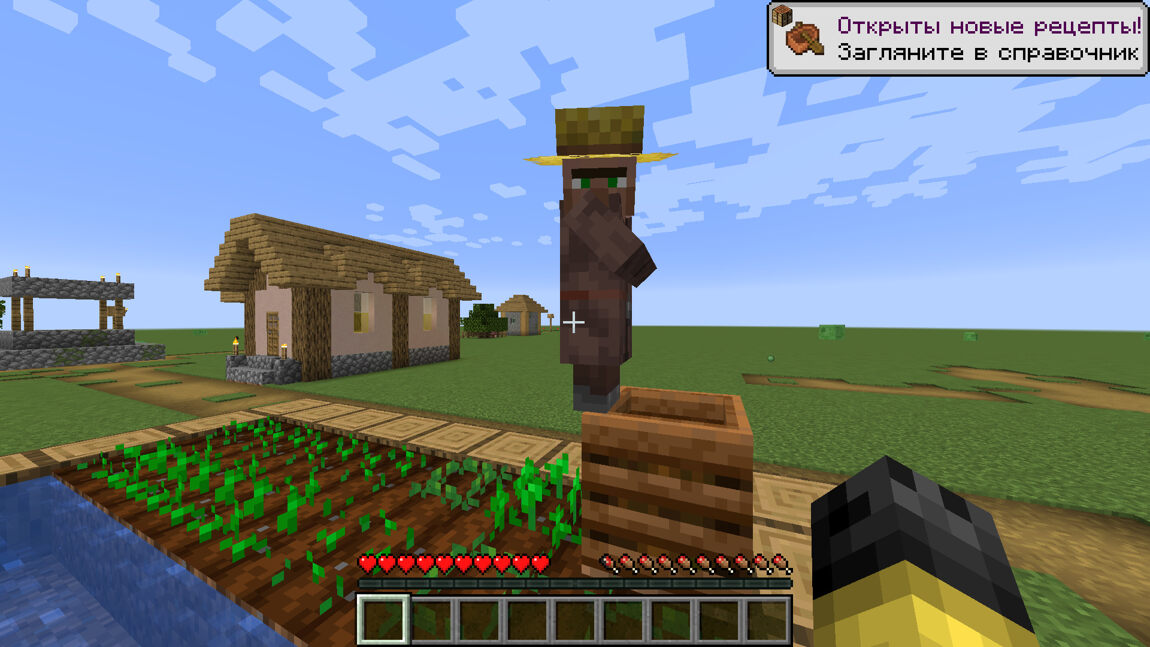
The first and easiest from a technical point of view is Minecraft Realms. The service assigns you a world where you can invite your friends of up to ten people. But there is a nuance: this service is paid and is available by monthly subscription. On the other hand, the money is taken only from the server owner, while the guests come without the slightest investment. If you want to try it yourself, there is a permanent offer for Realms - a free month trial. And then you decide whether to unpack your bank card. The question is not idle, because there are completely free ways to create your own server in Minecraft.
A popular solution in such cases is Hamachi. This is a service that is often used for multiplayer in those games where there are no dedicated servers. The application can be found and downloaded from the official site, and then create an account there. Next, the procedure is as follows: go to the menu "Network" and select the item "Create a new". Here you will be prompted to enter the ID and password - with their help, in addition to the host, four more users can connect to the session. After that, you need to go into "Minecraft", generate any world and open it for the network - in the lower left corner immediately shows a five-digit number. After a minute it disappears, but no problem: again, you can call it by pressing the T key. Anyone who wants to join the server must copy the IPv4 value to Hamachi, so that when you search for a server in Minecraft to enter in a window this address and through the colon the same world number. It looks like this: 12.12.123.12:12345. Server found? Then it's done.
A popular solution in such cases is Hamachi. This is a service that is often used for multiplayer in those games where there are no dedicated servers. The application can be found and downloaded from the official site, and then create an account there. Next, the procedure is as follows: go to the menu "Network" and select the item "Create a new". Here you will be prompted to enter the ID and password - with their help, in addition to the host, four more users can connect to the session. After that, you need to go into "Minecraft", generate any world and open it for the network - in the lower left corner immediately shows a five-digit number. After a minute it disappears, but no problem: again, you can call it by pressing the T key. Anyone who wants to join the server must copy the IPv4 value to Hamachi, so that when you search for a server in Minecraft to enter in a window this address and through the colon the same world number. It looks like this: 12.12.123.12:12345. Server found? Then it's done.
How to get minecoins and what to spend them on?
Since Minecraft is now owned by Microsoft, the corporation is clipping coupons in every way possible. The brand store sells maps, biomes, texture packs, mobs of all colors and sizes, different types of appearance for heroes (skins), and so on. Settlement in such purchases is a virtual currency - minecoin. And the easiest way to get them - to invest real money, that is, use donat. But the game is not free, they are asking almost $30, so why go broke on the decorations? For those who would like to get additional paid content, but do not want to lay out blood money, there are not many options, because minecoin - one of the most secure gaming currencies in the world.
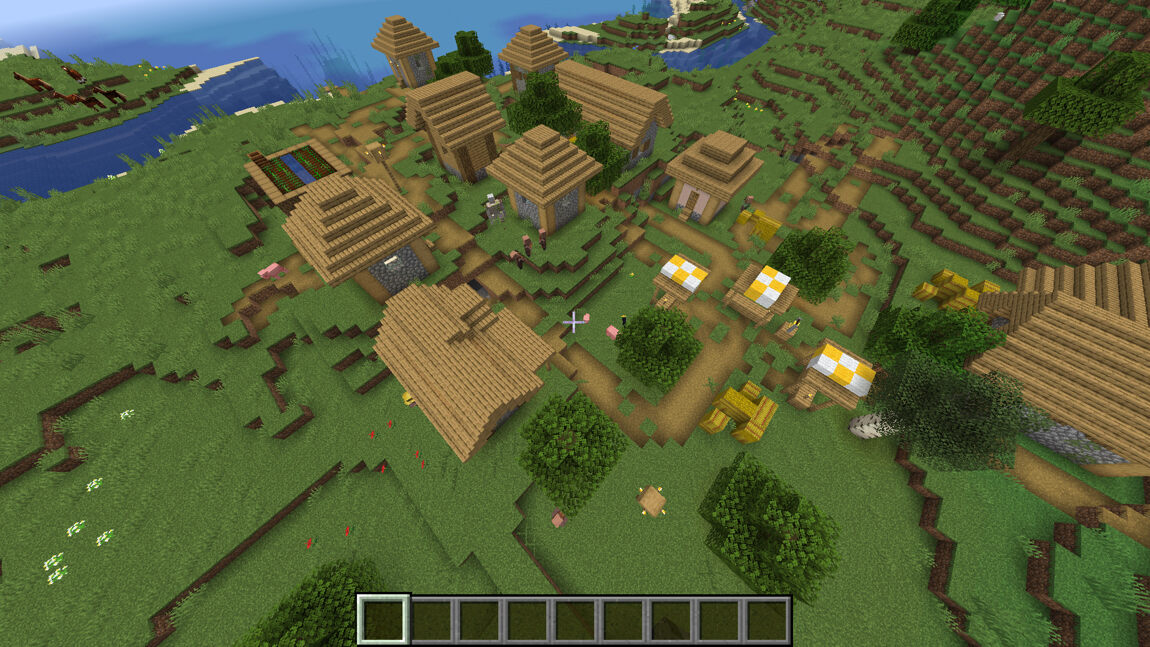
First of all, it is worth looking for promo codes. From time to time the game's publisher itself, represented by Microsoft (and the Xbox division), or popular Minecraft-themed video bloggers, hold promotions giving out such codes. Even Minecraft, despite its popularity, sometimes needs advertising and attracting new audiences. There are also not entirely legal methods of mining coins, which players resort to at their own risk. We will not discuss them, so "Google" to help. Be that as it may, it is important to remember that minecoin do not have any impact on the mechanics of the game and its constructive possibilities, and serve only for the purchase of jewelry. Therefore, virtual currency is mainly needed for those who would like to flaunt in the multiplayer a new character skin or gaze at exotic biomes.
Mods for Minecraft
Rarely can a game boast as many modifications as Markus Persson's work. Everything happened as the author intended: the main thing is the idea, and the fans will take care of its development. And if you decided to add to the classic version of "Minecraft" various improvements, you need Minecraft Forge - a universal tool for developing and downloading additional content. The program is downloaded from the official website and does not cost a penny. After installing the file with the desired add-on must be copied to the directory Mods inside the main folder with the game. It takes a couple of minutes, but how many opportunities then opens! We are primarily interested in that part of the client Forge, which is called ForgeModLoader - it is with her and download new mods.
Let's start with the graphical additions, because in its original state Minecraft looks like a reminiscence from the 90's: pixels with a coarse grind, cubes with edges you can cut yourself on, light and shadows asking you to finish them off so they don't suffer. It's hard to believe, but today even such simple-looking entertainment can be embellished beyond recognition. Ever heard of RTX, the real-time ray tracing technology that creates realistic reflections, highlights and shadows? Well, there is a way to make it all work in "Minecraft", if you have the appropriate video card of course. In pure form, the game does not support adding shaders, so you first need to download from the official website file GLSL Shaders, and then add graphic frills. All that remains is to download a mod with RTX support - and enjoy the effect. For Windows 10 users, this feature is available directly from the official publisher, so you don't need to download anything.
Let's start with the graphical additions, because in its original state Minecraft looks like a reminiscence from the 90's: pixels with a coarse grind, cubes with edges you can cut yourself on, light and shadows asking you to finish them off so they don't suffer. It's hard to believe, but today even such simple-looking entertainment can be embellished beyond recognition. Ever heard of RTX, the real-time ray tracing technology that creates realistic reflections, highlights and shadows? Well, there is a way to make it all work in "Minecraft", if you have the appropriate video card of course. In pure form, the game does not support adding shaders, so you first need to download from the official website file GLSL Shaders, and then add graphic frills. All that remains is to download a mod with RTX support - and enjoy the effect. For Windows 10 users, this feature is available directly from the official publisher, so you don't need to download anything.
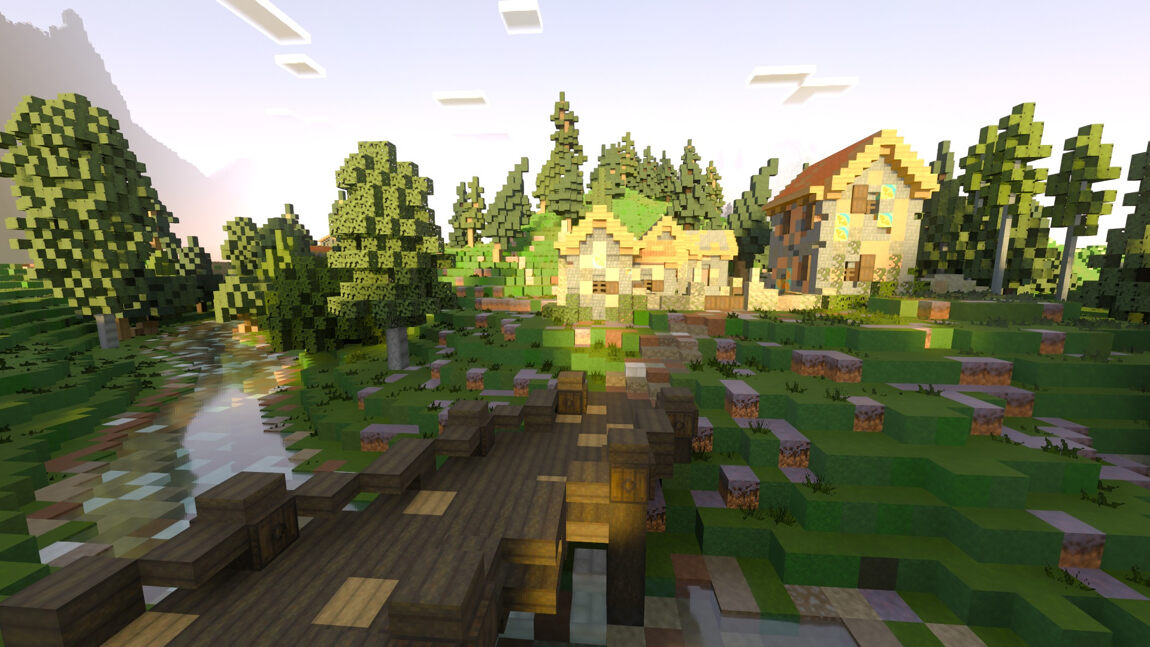
There are other ways to improve the picture: you can add swaying plants in the wind, high-resolution textures, depth of field, stylization as a cartoon. For owners of weak machines, too, there is a beauty: first, you must install the Optifine mod, which is responsible for optimizing graphics, and on top of that is already rolling some undemanding shaders, such as Sunflawer or Windom. However, overdo with the number of installations is not worth it. Minecraft Forge reduces conflicts between add-ons to a minimum, but all the problems with too many files from different developers it will not eliminate.
This is only a fraction of what fans of the game have come up with. There are also mods that change the mechanics of item creation, such as Tinkers Construct, adding interface elements, including a mini-map available in JourneyMap, new worlds, biomes, monsters, and more. You can download it all you want. However, in any case, you need to consider the capabilities of your computer and compatibility modifications to each other.
This is only a fraction of what fans of the game have come up with. There are also mods that change the mechanics of item creation, such as Tinkers Construct, adding interface elements, including a mini-map available in JourneyMap, new worlds, biomes, monsters, and more. You can download it all you want. However, in any case, you need to consider the capabilities of your computer and compatibility modifications to each other.
Conclusion
Minecraft is endless fun for the creative individual, a constructor of which there are few. Here you can survive, build, invent, learn new things and travel the vast world both alone and in the company of friends for a long time. Not to mention the use of the game in education and business, which has recently become fashionable. Sandboxes of this caliber have only one problem - time passes quickly. Otherwise, you won't find such a multifaceted and exciting project for the same price.
06 June 2021